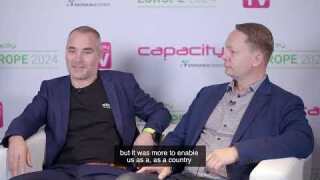Telecoms operators are on the hunt for start-ups to boost their innovation in key areas. That’s the consistent message from companies such as BT, Orange and TIM, all of which want not only to ensure they play a leading role in such areas as 5G, but also to help steer vendors to deliver what they need.
And all are aware that the giant over-the-top (OTT) companies are competing with them to develop new services for the same customers.
All told similar stories about the areas they regard as priorities – artificial intelligence (AI), security, the internet of things (IoT) and 5G appeared in all their lists. Softwarisation, the new and still awkward term that encompasses software-defined networks (SDN) and network functions virtualisation (NFV) is there too.
Most operators are looking for ways to interact with their customers more effectively – and here Orange is working together with Deutsche Telekom on a project to compete with the voice-activated assistants that OTTs such as Amazon, Apple, Google and Microsoft already have on the market.
“Our personal assistant is Djingo, for the B2B [business-to-business] and the B2C [business-to-consumer] market,” says Luc Bretones, the executive vice president of Orange’s Technocentre and of Orange Fab, the French group’s unit to find and invest in start-ups.
“It has been invented to be deployed across the Orange footprint. We began work on Djingo two years ago and that’s when it was first integrated with Orange apps.” It has natural language processing with a small speaker in the home “but in the future you will be able to manage Djingo in a car or with third-party devices.”
And Deutsche Telekom has joined forces with Orange to adopt Djingo, though the German operator will have its own name, says Bretones. “The customer relationship is our precious asset,” he says. “We cannot address all their needs but it is important to deliver the service.”
Both Orange and Deutsche Telekom will need to adopt the software for different languages across their markets and for localised services. “It will be different for different countries,” he says. And there will be business applications. “We have great traction with Orange Business Services to use it as a service platform – so businesses can design and build their own services with Orange engineers. We want to focus 100% on our services.”
Will other telcos be welcomed into the Djingo club? Bretones won’t say, but he points to SoftAtHome, the company that is developing middleware for services.
It’s a telco club, he says. For Djingo there are “a few partners at first, but when you have scale and speed you join forces with others.” At the moment the focus is on Deutsche Telekom but “the competition is global”. He adds: “SoftAtHome is a great success and we are thinking of this model.”
It’s the bigger carriers that have the resources to have their own innovation operation. In the old days when the original AT&T was fondly – or not so fondly – referred to as “Ma Bell” it ran Bell Labs, without a doubt one of the most successful industrial innovation machines ever, with more Nobel Prizes to its name than most countries.
Bell Labs is now part of Nokia as the latest stage in the process that began with the splitting up of the old Ma Bell in 1984 – and see page 60 for more of what it’s doing now. But the 21st century version of AT&T as well as Verizon have their own labs. Other global telcos with their own innovation labs include NTT in Japan and BT in the UK as well as the Orange Technocentre.
Tim Whitley is BT’s managing director of innovation, based at the company’s Adastral Park lab in the east of England.
“Innovation has been a thing BT has been passionate about for 181 years,” he says, laying claim again to BT’s idea that it dates back to the UK’s first telegraph companies.
Innovation has “got to be useful”, he says. “We don’t do blue-sky research.” But the company works with “40 or so universities” – not to pay them to do contract research, with a collaboration between BT staff and PhD and post-doc academics in a number of universities in the UK, China and elsewhere. He notes 5G innovation at the University of Surrey in the UK as well as work with the universities of Cambridge and Bristol and with King’s College London.
He works alongside Jean-Marc Frangos, the managing director of global innovation scouting, normally based in Silicon Valley, but on a visit to Adastral Park when we spoke. BT uses Silicon Valley as a base to look for start-ups. “We cannot say today that the world is completely centred in Silicon Valley,” says Frangos, “but every non-US start-up comes to the US to raise funding and they sometimes knock on our door.”
BT no longer looks to invest in start-ups but Frangos likes to form partnerships “that give us more freedom of choice”, he says. “We meet 500 start-ups a year worldwide and one in 10 we do some sort of work with – that could be diligence that we share back, or a proof of concept.” Why? “We have some of the world leaders and we see if what’s going on [in BT] is world-class. We ask if anyone has something that is really useful.”
In Italy, TIM is also on the lookout for start-ups, says Mario Di Mauro, the company’s chief of strategy, innovation and customer experience. TIM has what he calls an open innovation paradigm. “You cannot arrive at a commercial launch of a new technology and then wonder how to position the service,” he says.
This marks a different approach from the old days, when the industry delivered a new technology and then people looked for applications. Di Mauro recalls that he was around for the launch of 2G, 3G and 4G: the next, 5G, will be different, he implies.
TIM is working with several partners, including digital companies, small and medium enterprises, universities, local authorities and start-ups, he adds. “We try to anticipate what would be the service of the future. We have several trials, not only technology trials, but new business models. We felt the need to deploy open innovation for the 5G programme,” he says.
“We need to create additional value and we need to work in new markets. How can we add value and provide new services? We absolutely have to engage a lot of partners and new industries. Otherwise we have to work with the old paradigm.”
Whitley echoes this view that the telcos need to work with a wide community in order to find new services. “Why do companies continue with industrial research?” he asks. The answer: to find “really cool technology that improves services that we can launch into the market”.
But there’s another side: a company such as BT can take innovations to market and “compete on the global stage”. There are two reasons for this, he says. First, a telco needs to influence the global supply chain, “by conducting research to understand the art of the possible, particularly with operator colleagues and the supply base, companies like Huawei, Cisco, Ericsson and Nokia”.
That helps operators – in advance of procurement proposals – “to guide the global supply chain to produce the things that we want and to guide international standards”. For an operator to guide the standards organisations “you’ve got to be an active participant in international research – you need technology credentials”, he says.
Companies also need to look for what TIM’s Di Mauro calls “the wow effect”. He says: “We need to exceed the expectations of our customers. We need to see how the whole set of technology is developing to find what the customers want.”
Di Mauro believes that the industry – in Italy at least – is emerging from what he calls “a lost decade”, when OTTs gained momentum and telecoms companies lost value. But the new digital technologies “can give us some of the great opportunities we lost in the last 10 years”, he says. “If we see 5G as an evolving technology, then if we just look at throughput speed there will be no wow effect and no incremental revenue. We lag behind the digital native players.
We have a problem we need to fix.”
Or, as Orange’s Bretones might put it: “Djingo, we have a problem.”





